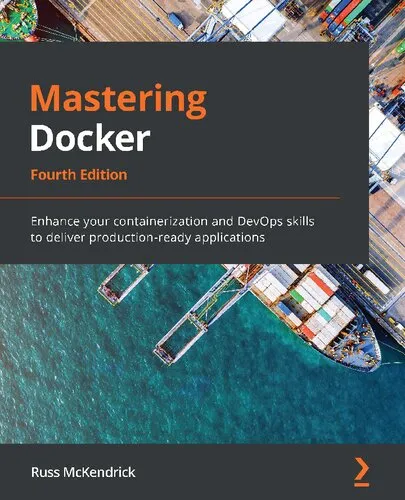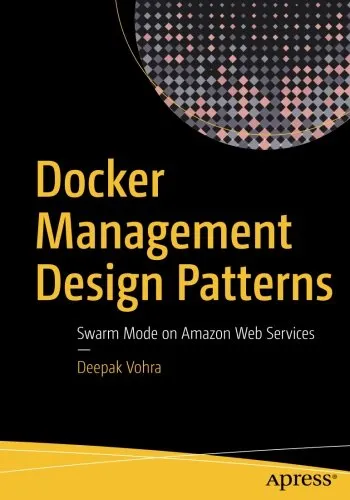Mastering Docker: Enhance your containerization and DevOps skills to deliver production-ready applications
5.0
بر اساس نظر کاربران

شما میتونید سوالاتتون در باره کتاب رو از هوش مصنوعیش بعد از ورود بپرسید
هر دانلود یا پرسش از هوش مصنوعی 2 امتیاز لازم دارد، برای بدست آوردن امتیاز رایگان، به صفحه ی راهنمای امتیازات سر بزنید و یک سری کار ارزشمند انجام بدینکتاب های مرتبط:
دانلود رایگان مستقیم
برای دانلود رایگان این کتاب و هزاران کتاب دیگه همین حالا عضو بشین
برای خواندن این کتاب باید نرم افزار PDF Reader را دانلود کنید Foxit Reader
دسترسی به کتابها از طریق پلتفرمهای قانونی و کتابخانههای عمومی نه تنها از حقوق نویسندگان و ناشران حمایت میکند، بلکه به پایداری فرهنگ کتابخوانی نیز کمک میرساند. پیش از دانلود، لحظهای به بررسی این گزینهها فکر کنید.
این کتاب رو در پلتفرم های دیگه ببینید
WorldCat به شما کمک میکنه تا کتاب ها رو در کتابخانه های سراسر دنیا پیدا کنید
امتیازها، نظرات تخصصی و صحبت ها درباره کتاب را در Goodreads ببینید
کتابهای کمیاب یا دست دوم را در AbeBooks پیدا کنید و بخرید
نظرات:
5.0
بر اساس 1 نظر کاربران
peter35
7 ژون 2025، ساعت 4:19
Chapter 1, Docker Overview, discusses where Docker came from and what it means to
developers, operators, and enterprises.
Chapter 2, Building Container Images, looks at the various ways in which you can build
your own container images.
Chapter 3, Storing and Distributing Images, looks at how we can share and distribute
images, now that we know how to build them.
x Preface
Chapter 4, Managing Containers, takes a deep dive into learning how to manage
containers.
Chapter 5, Docker Compose, looks at Docker Compose—a tool that allows us to share
applications comprising multiple containers.
Chapter 6, Docker Machine, Vagrant, and Multipass, looks at Docker Machine and other
tools that enable you to launch and manage Docker hosts on various platforms.
Chapter 7, Moving from Linux to Windows Containers, explains that, traditionally,
containers have been a Linux-based tool. Working with Docker, Microsoft has now
introduced Windows containers. In this chapter, we will look at the differences between
the two types of containers.
Chapter 8, Clustering with Docker Swarm, discusses how we have been targeting single
Docker hosts until this point. Docker Swarm is a clustering technology provided by
Docker that allows you to run your containers across multiple hosts.
Chapter 9, Portainer – a GUI for Docker, explains that most of our interaction with Docker
has been on the command line. Here, we will take a look at Portainer, a tool that allows
you to manage Docker resources from a web interface.
Chapter 10, Running Docker in Public Clouds, is where we look at the various ways in
which you can run your containers in public cloud services.
Chapter 11, Docker and Kubernetes, takes a look at Kubernetes. Like with Docker Swarm,
you can use Kubernetes to create and manage clusters that run your container-based
applications.
Chapter 12, Discovering other Kubernetes options, is where, having used Docker to run
Kubernetes locally, we take a look at other options for getting up and running with
Kubernetes on your local machine.
Chapter 13, Running Kubernetes in Public Clouds, takes a look at various Kubernetes
offerings from the 'big four' cloud providers: Azure, Google Cloud, Amazon Web Services,
and DigitalOcean
Chapter 14, Docker Security, takes a look at Docker security. We will cover everything
from the Docker host to how you launch your images, where you get them from, and the
content of your images.
Chapter 15, Docker Workflows, starts to put all the pieces together so that you can start
using Docker in your production environments and feel comfortable doing so.
Chapter 16, Next Steps with Docker, looks not only at how you can contribute to
Docker but also at the larger ecosystem that has sprung up to support container-based
applications and deployments.



